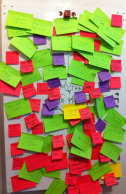|
Earlier this month, I was lucky to attend an awesome Design Thinking Bootcamp at the Stanford d.school in coordination with the Stanford Graduate School of Business. There were about 100 students from all sorts of companies, including many who flew quite far (Japan, Australia, Denmark, Oman, among others I met) to attend. I chose to do the program because the d.school opened around the time I graduated from Stanford, and I had always wanted to take some classes there in order to learn new problem-solving and creativity skills. This program was an awesome introduction to design thinking, which is a much different way of thinking about creativity, problem-solving, and innovation than traditionally taught. Some media, like the Wall Street Journal, have noticed this recently.
The focus of "d.thinking" is about learning from the world and people around you (instead of inside your head), primary observation and interviewing, and very rapid prototyping and iterating. The course itself followed these principles, focusing on learning by doing and minimizing lectures (with lectures ALSO focusing on showing rather than telling). At the d.school, there were about 20 coaches who worked closely with five-person student teams on an intensive project (redesigning the airport ground experience for jetBlue!). Getting a "backstage pass" through TSA and interviewing real people at SFO was an awesome way to learn "empathy," the first stage of the design process. And each team took the project in a different direction, culminating with full prototype testing and storytelling demonstrations to jetBlue VPs on day 3. The entire experience was fun and engaging, and the staff was awesome. I learned a lot and got the chance to meet and get to know some really smart and friendly people from around the world. What's really amazing is that the d.school offers all their materials and methods online for free (Creative Commons licenses). Sort of like the Coursera effort that Stanford spearheaded, it's clear the university cares about spreading knowledge and improving the state of "design thinking" for everyone. Below are my notes on Day 1 (blog posts about following days forthcoming). I plan to do my part to spread design thinking by promoting the methods and running an event or two to expose people to the methodology around Southern California. Let me know if you're interested in learning with me! Intro to Design Thinking (Gift Giving exercise) a. Step 1: interview b. Step 2: dig deeper i. Just ask why ii. Tell me more iii. If you can get your partner to cry, it’s good (therapists on staff) iv. Great design fueled by emotion v. Not incremental design; new territory vi. Go into tough territory w/ questions c. Reframe the problem d. Step 3: capture findings i. Needs/goals and wishes 1. Use verbs (not solutions) 2. Insights a. Trust instincts e. Step 4: take a stand w/ a POV i. REFRAME ii. Not just gift giving iii. Get off reservation iv. New subjects f. Ideate: generate alternatives to test g. Step 5: sketch at least 5 radical ways to meet your user’s needs i. No words, #s ii. Crappy sketches iii. Quantity over quality iv. Record of 17 sketches in 5 min in some class h. Step 6: share your solutions & capture feedback i. Another learning/empathy step i. Iterate based on feedback j. Step 7: reflect & generate a new solution k. Build and test l. Step 8: build your solution i. Not just small version ii. All about physical experience iii. Let your prototype go 1. Let go of it physically 2. Let go of it emotionally 3. Let it be destroyed, misused by partner 4. It’s just a tool to enable more learning of partner m. Step 9: share your solution and get feedback i. What worked ii. What could be improved iii. Questions iv. Ideas n. What feels like to be so lo-fi? o. Debrief i. Brag on your user ii. Brag on your designer p. Emotional catharsis: throwing away your prototype Empathy in Field c. Best to draw sketches of what you see around you, not just notes d. Debrief lecture i. Empathy map 1. Say 2. Think 3. Do 4. Feel ii. Unpacking onto empathy map: put post-its from stories you observed 1. As put up post-it, say it out loud iii. Observe: broad iv. Define: narrow, reframe as no one has done before v. Talk to people THEN define the problem vi. Go after the harder challenge when offered e. POV: user, needs, insight i. Insight: what did you notice that no one noticed ii. Choose the hard route iii. When choosing a milkshake flavor, just choose some milkshake flavor then will know if it feels right Takeaways from Day 1 i. Lean into it ii. Don’t jump to conclusion, reframe problem iii. Stories, details, don’t generalize iv. Beginner’s/child’s mind v. Freedom to not have agenda vi. Ask why and repeat vii. Moveable furniture rocks
1 Comment
Vera Shu
12/25/2018 05:34:44 am
Thank you so much for your sharing ! ^^
Reply
Your comment will be posted after it is approved.
Leave a Reply. |
Archives
June 2024
Categories
All
Subscribe |

 RSS Feed
RSS Feed
